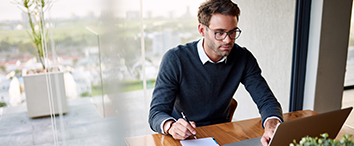The Post-COVID-19 Office: Physical Space Reimagined

With the first rays of post-pandemic light beginning to shine as the vaccine rolls out, it’s time for leaders to start planning the new working normal for organisations. While this will impact every aspect of business, have you considered what your physical space will need to adapt? Here we'll take a look at how the office could look in the new era.
Look at flipping those ratios
Lockdowns with enforced remote working has led many to conclude that the traditional 9-5 should be left on the pre-pandemic shelf. While some companies may decide to transition 100% of their workforce to 100% remote working, early indicators suggest most will opt for a hybrid approach, asking employees to be in-office on a set number of days and remote on the others. This impacts your physical space. Why have offices geared towards full staff and a full office if most will be working remotely? If your space is currently 75% desks and chairs, and 25% as relaxation and collaborative areas, you might want to consider flipping those ratios.
Desert island desks
The traditional desk will need to be reimagined in the new office space. While employees might once have enjoyed personalising their working areas, new ways of working mean a desk is now a more dynamic space, and not somebody’s personal domain. 'Hot desks’, which had begun to make an appearance in more progressive organisations pre-pandemic, will be the norm to make offices a more flexible space for people to drop by as needed. As the ratio of remote to office working levels out, having a scheduling system so employees can book a desk as needed will be crucial.
Flex your techs
Don’t be trapped by tradition. Try a flexi office, with a mix of regular desks and shallow, bar-height tables and stools placed strategically in attractive places. These tables have monitors and docking stations too, so it’s a functional workspace, but with less of a footprint. You could also consider tall-backed privacy couches as additional workspaces, with retractable power cables from the ceiling for power.
De-densify the office
Making a more modular, flexible use of the office space will be crucial as many employers will further embrace remote working opportunities. Some employees will still be working from the office however, so organisations will need to ensure employees can connect frequently and more seamlessly with each other. For example, you could have two people working in a smaller meeting room (while still socially distancing) communicating with those who are working from home. More meeting rooms, enhanced by swinging or motion sensor doors, or even no doors at all, will ensure teams are still seamlessly connecting and collaborating to the best of their ability, and the office space is best utilised.
Multi-purpose receptions
While the various vaccines might be bringing some hope, all the predictions, including those from the World Health Organization, say that COVID-19 will be with us for at least the remainder of 2021, if not beyond. As such, your reception area might need to become dual purpose, where it is used to welcome staff and visitors, but also to monitor their temperatures as they enter. Non-invasive, standalone infrared thermometers might be stationed immediately within your office entrance for the foreseeable future. A high temperature might then necessitate a nearby room for antigen testing.
Rewiring the hub
Increased remote working means increased IT infrastructure. You’ll already be speaking to your IT people about upgrading hardware, remote working policies and e-commerce platforms, but don’t forget to consider whether this new infrastructure requires more physical space in the office.
Mind and matter
Maybe with the changes ahead, you decide to remodel your premises, or even change location completely. Either way, bear in mind that staff needs have changed during the pandemic and companies need to consider the wellbeing of their workforce, including their physical and mental health. As such, do you need to set aside a specific area for this? Depending on the size of your company and its needs, this could range from a dedicated space where staff can talk privately to experts, to as grand as a multiple purpose room where you can do presentations as well as offer yoga, tai chi or rainbow rhythms dance classes.
Build back better, together
If we’re building back, we might as well build back better. As countries are starting to fold green issues into their COVID-19 recovery strategies, so companies should too. It’s just the right thing to do. Set yourself ambitious targets – could you go zero waste or carbon neutral? Get everyone excited and involved. Afterall, if everyone starts pulling together, it also helps foster team spirit and a sense of togetherness, which also helps with wellbeing. Win, win, win.
Right here right now
If you are remodeling and reimagining your workspaces, you’ll always want to future-proof your premises. Do some research and you’ll find companies like Vodaphone are installing innovations like heat-detection cameras that can check the temperatures of 100 people per minute. Similarly, Amazon uses AI-analysed security footage to ensure warehouse workers are maintaining social distancing. How could new and emerging technologies be used in your business? Think 5G, AI, AR, IoT, VR. The future is bright, and it’s got more acronyms than you can shake a Firestick at.
In our second blog in the post-COVID-19 office series here, we’ll explore how working practices will alter as organisations prepare and adapt for the new normal.